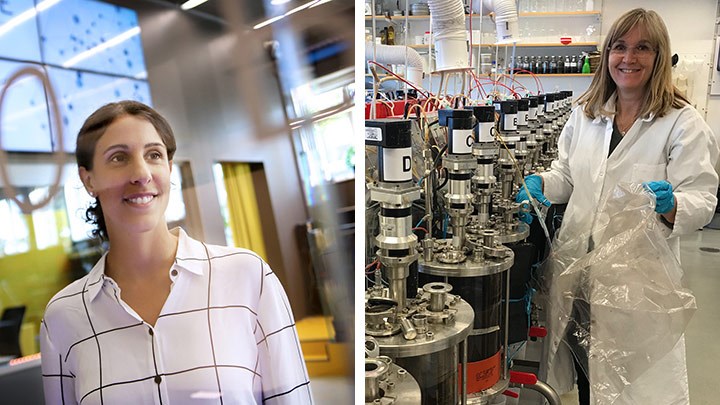New research project on biogas and AI

Amy Loutfi in the robotics lab at Örebro University and Anna Schnürer in the biogas lab at SLU, fuelling a biogas reactor.
Producing biogas more efficiently with the help of AI. That is the goal of a new research project at Örebro University and the Swedish University of Agricultural Sciences, SLU – and has been granted over SEK five million from the Swedish Energy Agency.
If Sweden is to achieve its environmental and climate goals, biogas will play a key role. New raw materials and more production facilities will be needed as production increases. And above all, a step up in technological development.
The chemical processes can be monitored and measured – degradation, gas production and fatty acids. However, it is more difficult to follow the microbiological processes, where the interaction of countless microorganisms is critical to the breakdown and conversion of waste into biogas.
“We will use AI to do this – and to examine the cause and link between these chemical and microbiological processes,” says Amy Loutfi, professor in information technology at Örebro University.
AI is the solution
While researchers describe how many plants run safely and without costly stops in production, they are also aware that settings are far from optimal.
“I am convinced that AI is the solution to understanding the highly complex microbiology that drives a biogas process,” says Anna Schnürer, professor of microbial biotechnology at SLU and who leads the new project.
“For us, it’s a win-win situation. We can help optimise the facilities and at the same time further develop the AI methods,” explains Amy Loutfi.
Text: Linda Harradine
Photo: Maria Westerholm and Jesper Eriksson
Translation: Jerry Gray
Biogas is a renewable energy source formed when organic matter such as manure, food waste, plant material or wastewater breaks down in anaerobic (lacking oxygen) environments. Biogas consists primarily of methane and carbon dioxide, along with a nutritious residue formed during decomposition, which can be used as fertiliser on farmlands.
In Sweden, the biogas process has long been used in wastewater treatment plants to stabilise sludge. In the 1970s, biogas plants were set up at sugar mills and paper pulp mills to treat wastewater, and since the 1980s, plants have been built to extract biogas from waste depots, food industries and food waste. Today, the number of plants is increasing, mainly for biogas production from manure. In addition, biogas can be used for heating, electricity and as fuel, helping to reduce greenhouse gas emissions.
In addition to researchers from Örebro University and the Swedish University of Agricultural Sciences, SLU, collaborating partners include biogas production plants driven via municipal companies and industry: Uppsala Vatten och Avfall AB, Tekniska verken i Linköping AB, Gasum, Scandinavian Biogas Fuels, ST1, HZI Jönköping Biogas. SLU’s own biogas facility at Swedish Livestock Research Centre in Lövsta is also a partner.
The project’s budget is SEK 7.5 million from the Swedish Energy Agency and partners, including SEK 1.5 million for research at Örebro University.
